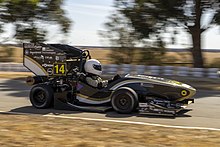Formula SAE
The concept behind Formula SAE is that a fictional manufacturing company has contracted a student design team to develop a small Formula-style race car.For example, best use of E-85 ethanol fuel, innovative use of electronics, recyclability, crash worthiness, analytical approach to design, and overall dynamic performance are some of the awards available.Its braking ability, rollover stability and noise levels are checked before the vehicle is allowed to compete in the dynamic events (Skidpad, Autocross, Acceleration, and Endurance).However, the lack of weight regulation combined with the somewhat fixed power ceiling encourages teams to adopt innovative weight-saving strategies, such as the use of composite materials, elaborate and expensive machining projects, and rapid prototyping.This rules change has marked a trend in engine downsizing in an attempt to save weight and increase fuel economy.Several top-running teams have switched from high-powered four-cylinder cars to smaller, one- or two-cylinder engines which, though they usually make much less power, allow weight savings of 75 lb (34 kg) or more, and also provide much better fuel economy.Tilt-tests ensure that no fluids will spill from the car under heavy cornering, and there must be no line-of-sight between the driver and fuel, coolant, or oil lines.Conceived by Dr. Kurt M. Marshek, the competition was inspired by a how-to article that appeared in Popular Mechanics magazine, for a small, "Indy-style" vehicle made out of wood, and powered by a five-horsepower Briggs and Stratton engine.UT SAE student branch members Robert Edwards and John Tellkamp led a discussion among UT SAE members and envisioned a competition that would involve designing and constructing a race car along the lines of the SCCA Formula 440 entry-level racing series that was popular at the time.The newly formed UT SAE branch, consisting mostly of automotive and motorcycle enthusiasts pursuing engineering degrees, including several who had left careers in fields for which the job market had virtually disappeared due to the depressed economy in the early 1980s – including some experienced auto mechanics, embraced and adopted the concept with little idea of what they were getting themselves into.SAE student branch officers Mike Best, Carl Morris, and Sylvia Obregon, along with Dr. Matthews began planning and organizing the event to be held the following year.While a sudden Texas rain storm sent everyone scrambling for cover just before the endurance event that day, the weather failed to dampen the spirits of the students, judges, or spectators and Formula SAE was born.In these subsequent years, UT moved the Formula SAE competition to other parking areas that included elevation changes and driveway aprons that forced the use of functioning suspensions.The rules for 1984 specifically allowed turbochargers, superchargers, and use of nitrous oxide but the engine had to breathe through a 25.4 mm exit bore of the carburetor casting (1984 was well before electronic fuel injection).The Formula SAE field had grown to eleven cars in 1984, so the University of Texas at Austin decided that the competition had matured sufficiently that it was safe to pass it on to other hosts.




Curtin UniversityUniversity of Texas at Austinstudent design competitionSAE InternationalUniversity of Michigan - Ann ArborTU GrazUniversity of Wisconsin - MadisonKansasPennsylvania State UniversityFormula-stylerace carautocrossGeneral MotorsChryslerCarroll SmithRon TauranacFormula StudentFormula SAE AustralasiaAustraliaHockenheimringFormula HybridNew Hampshire International Speedwayfour-strokeOtto-cycleair restrictorcompressorsport bikeV-twinsingle-cylinderWestern Washington UniversityUniversity of MelbourneUniversity of AucklandCarnegie Mellon Universityindependent suspensiondouble-wishbonewind tunnelcomputational fluid dynamicsrapid prototypingengine downsizingRochester Institute of TechnologyOregon State Universityroll hoopsimpact attenuatorUniversity of Texas at ArlingtonUniversity of HoustonPopular MechanicsIndy-styleBriggs and StrattonMini BajaUniversity of CincinnatiMichigan Technological UniversityList of Formula SAE winnersBaja SAEAssociation of Licensed Automobile ManufacturersSociété des ingénieurs de l'automobileARP4754ARP4761AS9000AS9100SAE J300SAE J306SAE J1587SAE J1708SAE J1772SAE J1939SAE J2452SAE J3068SAE J3105SAE J3400Wright Brothers MedalAndrew L. RikerHenry FordSAE AerodesignSAE Supermileage CompetitionEngineering Societies' BuildingSAE steel gradesSAE 304SAE 316SAE 316LSAE 440CSAE 630SAE 904L